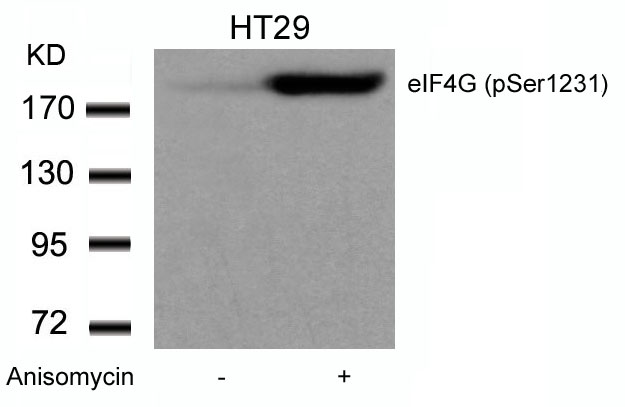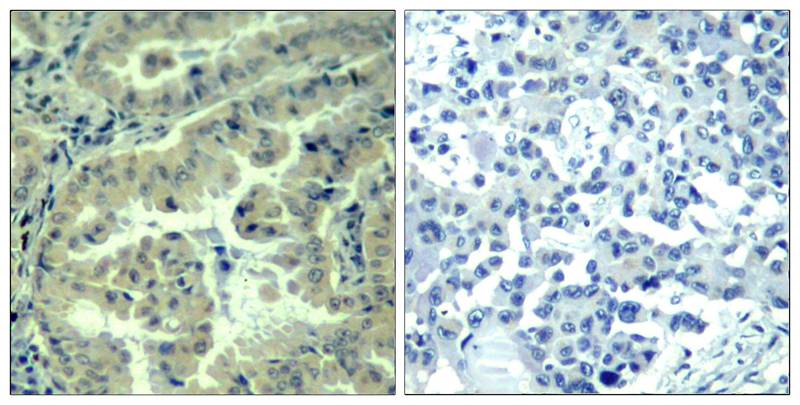

| WB | 咨询技术 | Human,Mouse,Rat |
| IF | 咨询技术 | Human,Mouse,Rat |
| IHC | 1/50-1/100 | Human,Mouse,Rat |
| ICC | 技术咨询 | Human,Mouse,Rat |
| FCM | 咨询技术 | Human,Mouse,Rat |
| Elisa | 咨询技术 | Human,Mouse,Rat |
| Entrez GeneID | 1981; |
| WB Predicted band size | 220kDa |
| Host/Isotype | Rabbit IgG |
| Antibody Type | Primary antibody |
| Storage | Store at 4°C short term. Aliquot and store at -20°C long term. Avoid freeze/thaw cycles. |
| Species Reactivity | Human |
| Immunogen | Peptide sequence around phosphorylation site of serine 1231 (P-V-S(p)-P-L) derived from Human eIF4G. |
| Formulation | Purified antibody in PBS with 0.05% sodium azide. |
+ +
1. **"mTOR signaling regulates the assembly and function of the eukaryotic translation initiation factor 4F complex"**
*作者:Holz MK, Ballif BA, Gygi SP, Blenis J*
摘要:研究通过质谱分析鉴定eIF4G在Ser1231的磷酸化位点,证实其受mTOR信号通路调控,并影响eIF4E-eIF4G复合体形成,从而调控帽依赖性翻译起始。
2. **"Phosphorylation of eIF4G is associated with translational activation of stored mRNAs in human cell lines"**
*作者:Gingras AC, Raught B, Sonenberg N*
摘要:探讨eIF4G磷酸化(包括Ser1231位点)在细胞应激恢复过程中对mRNA翻译再激活的作用,强调其在调控蛋白质合成中的关键性。
3. **"Amino acid-dependent regulation of eIF4G phosphorylation and mTOR signaling pathway"**
*作者:Raught B, Gingras AC, Gygi SP, et al.*
摘要:通过氨基酸饥饿/补充实验,揭示eIF4G Ser1231磷酸化依赖mTORC1活性,并参与细胞增殖与代谢适应的分子机制。
4. **"Functional characterization of phosphorylation sites in eIF4G using phosphospecific antibodies"**
*作者:Fletcher CM, Pestova TV, Hellen CU, et al.*
摘要:开发并验证eIF4G (phospho-Ser1231)抗体的特异性,证明该位点磷酸化增强eIF4G与eIF4E的结合能力,促进翻译起始复合体组装。
The eIF4G (phospho-Ser1231) antibody is a specialized tool used to study the phosphorylation status of eukaryotic translation initiation factor 4G (eIF4G) at serine residue 1231. eIF4G is a critical scaffolding protein in the translation initiation complex, where it bridges interactions between eIF4E (cap-binding protein), the poly(A)-binding protein (PABP), and other components to facilitate ribosome recruitment to mRNA. Phosphorylation at Ser1231 is a post-translational modification implicated in regulating eIF4G activity under various cellular conditions, including stress responses, cell cycle progression, and viral infection. This modification is thought to modulate interactions within the translation machinery or influence mRNA circularization, thereby fine-tuning protein synthesis.
The antibody is commonly used in techniques like Western blotting, immunofluorescence, or immunoprecipitation to investigate translational control mechanisms in contexts such as cancer, neurodegeneration, or viral replication. Its specificity for the phosphorylated Ser1231 epitope allows researchers to assess dynamic changes in eIF4G activation states, particularly in signaling pathways involving kinases like MNK1/2. Validation typically includes testing in phosphorylation-deficient mutants or under kinase-inhibition conditions. Understanding eIF4G phosphorylation provides insights into cellular adaptation to stress and dysregulated translation in disease.
×